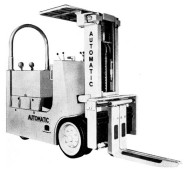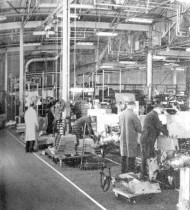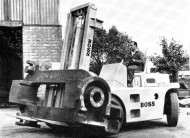 Warehouse & Logistics News is proud to bring you the forty-eighth instalment in our exclusive series on the history of the fork lift truck, the machine that over the decades has revolutionised the face of materials handling around the world.
Warehouse & Logistics News is proud to bring you the forty-eighth instalment in our exclusive series on the history of the fork lift truck, the machine that over the decades has revolutionised the face of materials handling around the world.
Our writer is James Brindley, an acknowledged authority on fork lift trucks. James’s distinguished career has involved engineering and management roles with BT Rolatruc and serving as a Director of the Fork Lift Truck Association, before he set up the National Fork Truck Heritage Centre in 2004 as Britain’s first such collection open to the public.
The Heritage Centre continues to need your support in 2010, and if you or your company would like to help in any way, you can contact James on the number below. Now sit back and enjoy the latest part of this fascinating series.
Episode 48: 1965: Boss rolls out specialist trucks
In January 1965, following the opening of their new factory in Leighton Buzzard during the latter half of the previous year, Boss (Engineers) Ltd released details of two new front lift fork lift trucks. These were the A25/48 bulk container handler and the H12 Compact, the latter of which the company claimed was the smallest lift truck of its capacity in Europe. The model A25/48, with a lifting capacity of up to 25,000 lbs at 48 inches, was primarily designed to operate within the recommendation of the International Standards Organisation on container sizes. With a turning circle of only 16 feet the truck was also very manoeuvrable in confined spaces. Such was the truck’s performance that it was advertised to work in ships’ holds and to further emphasise the fact, it was available with a quick release counterweight and detachable mast so that it could be lowered into the ship’s hold by dockside cranes of limited capacity. Power was supplied by a Leyland 400s diesel engine, driving through a torque converter to give three speeds in forward and reverse. The H12 Compact had a maximum lifting capacity of 12,000 lbs at 24 inches. Quoted as having the same physical dimensions of an 8,000 lb machine, it was claimed by the manufacturers to replace the 8,000lb and 10,000 lb machines without necessitating any change in layout or gangway dimensions. A Ford 592 E, 4 cylinder diesel engine supplied the power, but a petrol or LPG engine was offered as an option. As with the A25/48 quick release counterweights could be fitted for ship’s hold working.
 In February the American company, Automatic, produced the third of its models in its range for operation in the steel industry. The LHR heavy duty truck, with a lifting capacity of 30,000lbs, could be used as a ram truck or as a conventional fork lift. The machine had two drive motors, on a single drive axle, which could be connected in series for high torque and low current consumption or in parallel for fast travel.
In February the American company, Automatic, produced the third of its models in its range for operation in the steel industry. The LHR heavy duty truck, with a lifting capacity of 30,000lbs, could be used as a ram truck or as a conventional fork lift. The machine had two drive motors, on a single drive axle, which could be connected in series for high torque and low current consumption or in parallel for fast travel.
Also in February, Stacatruc Ltd found that increasing demand for battery operated forklifts had made it necessary to step up production at their Birmingham factory. They claimed that the new line would increase production by 50 percent and was the first stage in an expansion programme to meet increased orders from overseas. The next stage in the programme would be a new production line for reach trucks and pedestrian controlled vehicles.
In April the manufacturer Boss was again in the news with a recovery vehicle for Forth Bridge rescues. Based on their model B26 with a lifting capacity of 26,000 lb at 24 inch load centres, the forklift truck would be used to clear breakdowns and accidents from the entire length of the bridge. The truck was fitted with a 10 foot duplex mast and on its rear end a mechanical winch. The fork carriage, which was fitted with hydraulically operated 72 inch long forks, also had three shackle eyes for towing purposes. Heavy strip rubber bumpers were fitted front and rear for pushing disabled lorries if required. The company stated that they already had smaller rescue trucks based in the Severn Tunnel.
 At this time a new chemical was introduced onto the British market that would assist most forklift engineers. In 1953 the Rocket Chemical Company set out to create rust prevention and degreasing solutions for the aerospace industry. One of the results of this experimentation was an anticorrosion treatment. The formula, then called Rocket WD 40, was originally used to protect the outer skin of the American Atlas Missile from deterioration. Its sales name of WD40 stands for Water Displacement, which was perfected on the 40th attempt. The product’s chemical description stated that it displaced moisture and replaced it by depositing inhibitors into the grain boundary of metals, providing a moisture barrier.
At this time a new chemical was introduced onto the British market that would assist most forklift engineers. In 1953 the Rocket Chemical Company set out to create rust prevention and degreasing solutions for the aerospace industry. One of the results of this experimentation was an anticorrosion treatment. The formula, then called Rocket WD 40, was originally used to protect the outer skin of the American Atlas Missile from deterioration. Its sales name of WD40 stands for Water Displacement, which was perfected on the 40th attempt. The product’s chemical description stated that it displaced moisture and replaced it by depositing inhibitors into the grain boundary of metals, providing a moisture barrier.
To be continued
By James Brindley, Director, National Fork Truck Heritage Centre.
If you would like to support the National Fork Truck Heritage Centre, please call James Brindley on 0780 195 4167




Comments are closed.